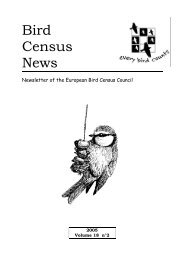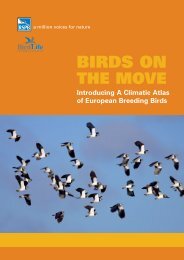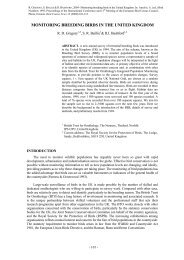Quantifying the impact of land-use change to European farmland ...
Quantifying the impact of land-use change to European farmland ...
Quantifying the impact of land-use change to European farmland ...
You also want an ePaper? Increase the reach of your titles
YUMPU automatically turns print PDFs into web optimized ePapers that Google loves.
352 S.J. Butler et al. / Agriculture, Ecosystems and Environment 137 (2010) 348–357<br />
this bootstrapping process 1000 times <strong>to</strong> generate a distribution <strong>of</strong><br />
predicted EFBIs, from which we estimated <strong>the</strong> mean. The 25th and<br />
975th EFBI values <strong>of</strong> <strong>the</strong> 1000 bootstrapped samples, when ordered<br />
by size, were <strong>use</strong>d <strong>to</strong> estimate <strong>the</strong> 95% confidence limits <strong>of</strong> this<br />
mean EFBI. In this way, we generated a predicted EFBI with associated<br />
confidence limits that could be compared with <strong>the</strong> observed<br />
value associated with past agricultural <strong>change</strong>s. This process was<br />
repeated <strong>to</strong> assess <strong>the</strong> performance <strong>of</strong> <strong>the</strong> SCALE framework.<br />
2.5. Identifying key sources <strong>of</strong> risk in current agricultural<br />
<strong>land</strong>scapes<br />
We identified <strong>the</strong> main sources <strong>of</strong> risk <strong>to</strong> farm<strong>land</strong> birds in<br />
current agricultural <strong>land</strong>scapes using <strong>the</strong> scores derived from <strong>the</strong><br />
validation <strong>of</strong> <strong>the</strong> BASIC framework. The scores from all 54 farm<strong>land</strong><br />
bird species were summed <strong>to</strong> give a <strong>to</strong>tal <strong>land</strong>scape risk score.<br />
This was <strong>the</strong>n broken down according <strong>to</strong> <strong>the</strong> source <strong>of</strong> that risk; we<br />
calculated <strong>the</strong> proportion <strong>of</strong> <strong>to</strong>tal risk arising from <strong>change</strong>s <strong>to</strong> food<br />
abundance, ei<strong>the</strong>r through <strong>the</strong> loss <strong>of</strong> foraging habitat or <strong>the</strong> loss <strong>of</strong><br />
prey items in existing habitat, and nesting success, ei<strong>the</strong>r through<br />
<strong>the</strong> loss <strong>of</strong> nesting habitat or reduced success in existing habitat, in<br />
cropped areas, margins and hedgerows. Note that margin refers <strong>to</strong><br />
non-cropped open habitats in <strong>the</strong> <strong>land</strong>scape and hedgerow refers <strong>to</strong><br />
structural vegetation elements in <strong>the</strong> <strong>land</strong>scape such as hedgerows<br />
and trees. Again, this process was repeated using scores derived<br />
from <strong>the</strong> validation <strong>of</strong> <strong>the</strong> SCALE framework.<br />
2.6. Assessing <strong>the</strong> relative contribution <strong>of</strong> member states <strong>to</strong> <strong>the</strong><br />
EFBI<br />
Given that species’ pan-<strong>European</strong> risk scores are related <strong>to</strong> <strong>the</strong>ir<br />
pan-<strong>European</strong> population trends (see Section 3.1), it is possible <strong>to</strong><br />
estimate <strong>the</strong> relative contribution <strong>of</strong> each member state <strong>to</strong> <strong>the</strong> current<br />
level <strong>of</strong> <strong>the</strong> EFBI by assessing its relative contribution <strong>to</strong> <strong>the</strong><br />
risk score <strong>of</strong> each species included in <strong>the</strong> EFBI. These analyses were<br />
undertaken separately on risk scores generated from <strong>the</strong> validation<br />
<strong>of</strong> <strong>the</strong> BASIC and SCALE frameworks. To do this, we allocated <strong>the</strong> risk<br />
score <strong>of</strong> each breeding population <strong>to</strong> <strong>the</strong> countries in which that risk<br />
had been accrued. Thus <strong>the</strong> summer risk component <strong>of</strong> a breeding<br />
populations’ <strong>to</strong>tal risk score was assigned <strong>to</strong> <strong>the</strong> country in which<br />
it bred whilst <strong>the</strong> winter risk score component was assigned <strong>to</strong> <strong>the</strong><br />
country or countries in which it over-wintered. Since <strong>the</strong> wintering<br />
locations <strong>of</strong> non-resident populations were only identified at a<br />
regional level, <strong>the</strong>ir winter risk was distributed between <strong>the</strong> overwintering<br />
regions identified and between <strong>the</strong> constituent countries<br />
within each over-wintering region in proportion <strong>to</strong> <strong>the</strong>ir UAA. Take,<br />
for example, <strong>the</strong> Swedish breeding population <strong>of</strong> skylarks. Using<br />
<strong>the</strong> BASIC framework, a <strong>to</strong>tal risk score <strong>of</strong> 17 was calculated for this<br />
population, with 12 accrued in <strong>the</strong> summer and 5 accrued in <strong>the</strong><br />
winter. However, <strong>the</strong> Swedish population <strong>of</strong> skylarks is migra<strong>to</strong>ry<br />
and its winter risk reflects detrimental <strong>change</strong>s in resource availability<br />
in <strong>the</strong> West and South region, where it over-winters, ra<strong>the</strong>r<br />
than <strong>change</strong>s that have occurred in Sweden. For this population, all<br />
<strong>of</strong> <strong>the</strong> summer risk but none <strong>of</strong> its winter risk was assigned <strong>to</strong> Sweden.<br />
Instead, <strong>the</strong> winter risk was divided between <strong>the</strong> countries in<br />
<strong>the</strong> West region and South region according <strong>to</strong> <strong>the</strong>ir relative UAA.<br />
For each country, we <strong>the</strong>n summed <strong>the</strong> level <strong>of</strong> risk contributed <strong>to</strong><br />
all breeding populations <strong>of</strong> each species so that, for example, <strong>the</strong><br />
score derived for skylark in France represented <strong>the</strong> risk accrued<br />
by <strong>the</strong> breeding population in France plus any winter risk accrued<br />
by breeding populations in <strong>the</strong> o<strong>the</strong>r countries as a consequence<br />
<strong>of</strong> France being one <strong>of</strong> <strong>the</strong>ir over-wintering destinations. The sum<br />
<strong>of</strong> every country’s score for a given species was identical <strong>to</strong> that<br />
species’ pan-<strong>European</strong> risk score calculated in Section 2.3.2.1. We<br />
<strong>the</strong>n calculated <strong>the</strong> proportional contribution <strong>of</strong> each country <strong>to</strong> <strong>the</strong><br />
pan-<strong>European</strong> risk score <strong>of</strong> each species in <strong>the</strong> EFBI and summed<br />
<strong>the</strong>se values across species <strong>to</strong> identify <strong>the</strong> relative contribution <strong>of</strong><br />
each country <strong>to</strong> <strong>the</strong> <strong>European</strong> risk scores <strong>of</strong> all species in <strong>the</strong> EFBI<br />
and hence <strong>to</strong> <strong>the</strong> current level <strong>of</strong> <strong>the</strong> EFBI.<br />
Finally, we compared <strong>the</strong> relative contribution <strong>of</strong> each country<br />
<strong>to</strong> <strong>the</strong> EFBI with <strong>the</strong> allocation <strong>of</strong> Pillar 2 funding <strong>to</strong> Axis 2 measures,<br />
including AES, during <strong>the</strong> 2007–2013 budget period. We controlled<br />
for UAA <strong>to</strong> explore <strong>the</strong> relationship between <strong>the</strong>se two variables at<br />
a per unit area scale. A positive relationship would indicate that<br />
funding is being directed in a targeted fashion among Member<br />
States, with more money available for mitigation measures in countries<br />
contributing relatively more <strong>to</strong> <strong>the</strong> EFBI, although it would<br />
say nothing about <strong>the</strong> implementation or effectiveness <strong>of</strong> any such<br />
measures.<br />
2.7. Scenario assessment<br />
The BASIC framework can be <strong>use</strong>d <strong>to</strong> predict <strong>the</strong> likely <strong>impact</strong>s<br />
on farm<strong>land</strong> bird populations <strong>of</strong> novel <strong>land</strong>-<strong>use</strong> and management<br />
<strong>change</strong>s, for which no baseline against which <strong>the</strong> scale <strong>of</strong> that<br />
<strong>change</strong> can be compared is available. The SCALE framework can<br />
be <strong>use</strong>d <strong>to</strong> predict <strong>the</strong> likely <strong>impact</strong>s on farm<strong>land</strong> bird populations<br />
<strong>of</strong> a <strong>change</strong> in <strong>the</strong> intensity or extent <strong>of</strong> existing agricultural practices<br />
and <strong>land</strong>-<strong>use</strong>s. Here we assess <strong>the</strong> <strong>impact</strong>s <strong>of</strong> four scenarios<br />
<strong>of</strong> <strong>land</strong>-<strong>use</strong> <strong>change</strong> over <strong>the</strong> next decade <strong>to</strong> demonstrate <strong>the</strong> range<br />
<strong>of</strong> application <strong>of</strong> <strong>the</strong> two risk assessment frameworks.<br />
2.7.1. Scenario 1: current conditions persist<br />
This scenario extends current conditions in agricultural <strong>land</strong>scapes<br />
through <strong>to</strong> 2020, with current rates <strong>of</strong> intensification and<br />
abandonment in each <strong>of</strong> <strong>the</strong> four regions maintained for <strong>the</strong> next<br />
decade. Predictions <strong>of</strong> <strong>the</strong> expected EFBI under this scenario were<br />
made using both <strong>the</strong> BASIC and SCALE frameworks.<br />
2.7.2. Scenario 2: loss <strong>of</strong> compulsory set-aside<br />
The removal <strong>of</strong> set-aside support across Europe following <strong>the</strong><br />
2008 CAP ‘Health check’ is likely <strong>to</strong> lead <strong>to</strong> a reduction in <strong>the</strong> availability<br />
<strong>of</strong> over-wintered stubbles in <strong>the</strong> agricultural <strong>land</strong>scape. Any<br />
over-wintered stubbles that do persist in <strong>the</strong> <strong>land</strong>scape can be<br />
expected <strong>to</strong> have reduced weed seed availability due <strong>to</strong> associated<br />
<strong>change</strong>s in crop rotation and management. The temporal <strong>change</strong>s<br />
in vegetation structure over <strong>the</strong> course <strong>of</strong> <strong>the</strong> summer will also lead<br />
<strong>to</strong> a reduction in summer foraging habitat and nest site availability<br />
due <strong>to</strong> reduced access. As this scenario represents a novel <strong>land</strong>-<strong>use</strong><br />
<strong>change</strong> we <strong>use</strong>d <strong>the</strong> BASIC framework <strong>to</strong> calculate <strong>the</strong> risk <strong>to</strong> each<br />
species as a consequence <strong>of</strong> <strong>the</strong>se <strong>change</strong>s in resource availability.<br />
2.7.3. Scenario 3: accelerated agricultural intensification in <strong>the</strong><br />
East region<br />
This scenario represents a <strong>change</strong> in <strong>the</strong> intensity <strong>of</strong> existing<br />
<strong>land</strong>-<strong>use</strong> and practices so <strong>the</strong> SCALE framework was employed here.<br />
We specified that <strong>the</strong> level <strong>of</strong> agricultural intensification in <strong>the</strong> East<br />
region, as indicated by cereal yield, would reach <strong>the</strong> 2005 levels in<br />
<strong>the</strong> West region by 2020. We calculated <strong>the</strong> rate <strong>of</strong> <strong>change</strong> in cereal<br />
yield between 2005 and 2020 required <strong>to</strong> achieve this level and set<br />
<strong>the</strong> intensification scaling fac<strong>to</strong>r for <strong>the</strong> East region <strong>to</strong> this value.<br />
We assumed that no fur<strong>the</strong>r <strong>land</strong> abandonment occurred and that<br />
cereal yields in <strong>the</strong> West, North and South regions remained at 2005<br />
levels so <strong>the</strong> scaling fac<strong>to</strong>rs for <strong>the</strong>se components were all set <strong>to</strong><br />
zero.<br />
2.7.4. Scenario 4: continued <strong>land</strong> abandonment across Europe<br />
This scenario represents a <strong>change</strong> in <strong>the</strong> scale <strong>of</strong> existing <strong>land</strong><strong>use</strong><br />
and practices so <strong>the</strong> SCALE framework was again employed<br />
here. We assessed <strong>the</strong> consequences <strong>of</strong> three different levels <strong>of</strong> <strong>land</strong><br />
abandonment on farm<strong>land</strong> bird populations. Specifically, we calculated<br />
<strong>the</strong> rate <strong>of</strong> <strong>change</strong> in UAA which would result in a 5%, 10% and






